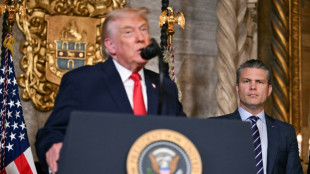

Could copper tariff hurt US more than Chile?
Chile, the world's biggest copper producer, is hoping for a last-minute deal to stop the United States from imposing a 50-percent import tariff on the red metal.
If not, the South American country should be able to easily find other buyers for a metal deemed critical for the artificial intelligence and green energy revolutions, analysts say.
Chile is the largest provider of copper to the United States, whose President Donald Trump announced a punishing levy on the metal starting Friday.
Government sources in Santiago told AFP delegations have been talking behind closed doors since Monday, seeking a Trump-pleasing deal that will in effect replace a free trade agreement in place since 2004.
- Impact on the US -
The United States imports about 45 percent of the copper it needs for industrial use, according to the US Geological Survey, a government agency. Of that, it gets 51 percent from Chile.
According to Trump himself, it is "the second most used material by the Department of Defense" -- used in semiconductors, planes, ships, ammunition, data centers and missile defense systems.
Trump "wants to revitalize a domestic industry that has faded and has been overtaken by China and has become reliant on foreign imports," Andy Cole, an analyst with the London-based Fastmarkets price-tracking agency, told AFP.
Raising the tariff on imported copper will increase US production costs, which may boost demand for domestically sourced copper.
But the United States does not have the capacity to increase its production overnight, and "in the long run the losers will be US consumers if they have the pay more for copper," said Cole.
Juan Carlos Guajardo, director of Chilean consulting firm Plusmining, said the United States would need to produce between 600,000 and 800,000 tons of copper per year for its domestic industry, and would not be able to reach that level for "at least 10 years."
- Impact on Chile -
Chile is responsible for nearly a quarter of global copper supply, which contributes 10 to 15 percent to its GDP.
Its Finance Minister Mario Marcel has warned of "medium-term" damage from a 50-percent tariff, but said the country could mitigate longer-term harms through "market diversification."
For Guajardo, this means Chile can "redirect its copper," particularly "to Southeast Asia and India" or even Europe.
China is by far the leading buyer of Chilean copper, accounting for 52 percent -- totaling $26 billion --in 2024, according to the South American country's central bank.
The United States occupied a distant second place with imports worth $5.8 billion from Chile, followed by Japan with $5.3 billion and South Korea with $2.8 billion.
According to Maurice Obstfeld, an economics professor at the University of California, Berkeley, "copper importers other than the US could gain" from the tariff hike.
- Exception? -
Chile says it has not been officially notified of the August 1 starting date for a copper tariff, and is still hoping to avoid it.
The country's foreign ministry has said "confidential" talks with US delegates would continue to the last minute.
According to Marcel, copper itself is not formally on the negotiating table, but will likely be included.
"For this type of raw material, exceptions have been made in other agreements," he told Radio Duna earlier this week.
After Trump's announcement on July 8, the price of copper soared to record levels in New York.
US buyers rushed to stockpile the red metal before August 1, paying prices sometimes as much as 30 percent higher than in London.
A.Fredriksson--StDgbl






